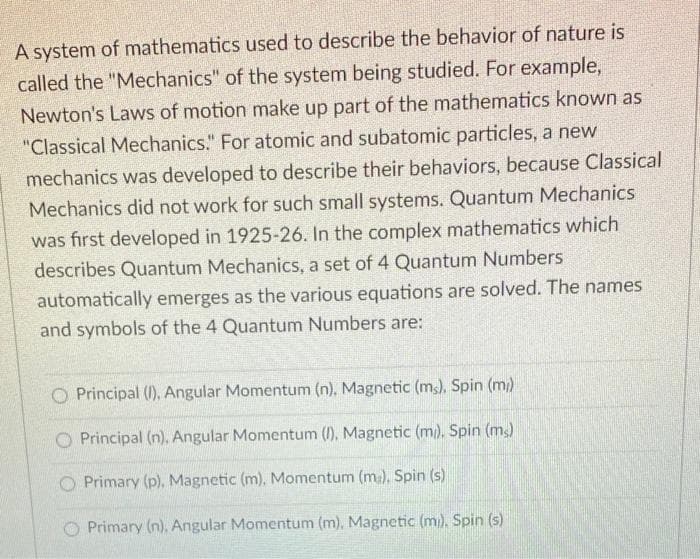A system of mathematics used to describe the behavior of nature is called the "Mechanics" of the system being studied. For example, Newton's Laws of motion make up part of the mathematics known as "Classical Mechanics." For atomic and subatomic particles, a new mechanics was developed to describe their behaviors, because Classical Mechanics did not work for such small systems. Quantum Mechanics was first developed in 1925-26. In the complex mathematics which describes Quantum Mechanics, a set of 4 Quantum Numbers automatically emerges as the various equations are solved. The names and symbols of the 4 Quantum Numbers are: Principal (1), Angular Momentum (n), Magnetic (ms), Spin (m) O Principal (n), Angular Momentum (1), Magnetic (m). Spin (m.) O Primary (p), Magnetic (m), Momentum (m), Spin (s) O Primary (n), Angular Momentum (m), Magnetic (m). Spin (s)
A system of mathematics used to describe the behavior of nature is called the "Mechanics" of the system being studied. For example, Newton's Laws of motion make up part of the mathematics known as "Classical Mechanics." For atomic and subatomic particles, a new mechanics was developed to describe their behaviors, because Classical Mechanics did not work for such small systems. Quantum Mechanics was first developed in 1925-26. In the complex mathematics which describes Quantum Mechanics, a set of 4 Quantum Numbers automatically emerges as the various equations are solved. The names and symbols of the 4 Quantum Numbers are: Principal (1), Angular Momentum (n), Magnetic (ms), Spin (m) O Principal (n), Angular Momentum (1), Magnetic (m). Spin (m.) O Primary (p), Magnetic (m), Momentum (m), Spin (s) O Primary (n), Angular Momentum (m), Magnetic (m). Spin (s)
Introductory Chemistry: A Foundation
9th Edition
ISBN:9781337399425
Author:Steven S. Zumdahl, Donald J. DeCoste
Publisher:Steven S. Zumdahl, Donald J. DeCoste
Chapter12: Chemical Bonding
Section: Chapter Questions
Problem 17CR: Schrodinger and de Broglie suggested a ‘Wave—particle duality" for small particles—that is, if...
Related questions
Question
4.

Transcribed Image Text:A system of mathematics used to describe the behavior of nature is
called the "Mechanics" of the system being studied. For example,
Newton's Laws of motion make up part of the mathematics known as
"Classical Mechanics." For atomic and subatomic particles, a new
mechanics was developed to describe their behaviors, because Classical
Mechanics did not work for such small systems. Quantum Mechanics
was first developed in 1925-26. In the complex mathematics which
describes Quantum Mechanics, a set of 4 Quantum Numbers
automatically emerges as the various equations are solved. The names
and symbols of the 4 Quantum Numbers are:
O Principal (1), Angular Momentum (n), Magnetic (ms), Spin (m)
O Principal (n), Angular Momentum (I), Magnetic (m). Spin (m)
O Primary (p), Magnetic (m), Momentum (m.), Spin (s)
O Primary (n), Angular Momentum (m), Magnetic (m). Spin (s)
Expert Solution
This question has been solved!
Explore an expertly crafted, step-by-step solution for a thorough understanding of key concepts.
This is a popular solution!
Trending now
This is a popular solution!
Step by step
Solved in 2 steps with 1 images

Knowledge Booster
Learn more about
Need a deep-dive on the concept behind this application? Look no further. Learn more about this topic, chemistry and related others by exploring similar questions and additional content below.Recommended textbooks for you

Introductory Chemistry: A Foundation
Chemistry
ISBN:
9781337399425
Author:
Steven S. Zumdahl, Donald J. DeCoste
Publisher:
Cengage Learning

Physical Chemistry
Chemistry
ISBN:
9781133958437
Author:
Ball, David W. (david Warren), BAER, Tomas
Publisher:
Wadsworth Cengage Learning,

Principles of Modern Chemistry
Chemistry
ISBN:
9781305079113
Author:
David W. Oxtoby, H. Pat Gillis, Laurie J. Butler
Publisher:
Cengage Learning

Introductory Chemistry: A Foundation
Chemistry
ISBN:
9781337399425
Author:
Steven S. Zumdahl, Donald J. DeCoste
Publisher:
Cengage Learning

Physical Chemistry
Chemistry
ISBN:
9781133958437
Author:
Ball, David W. (david Warren), BAER, Tomas
Publisher:
Wadsworth Cengage Learning,

Principles of Modern Chemistry
Chemistry
ISBN:
9781305079113
Author:
David W. Oxtoby, H. Pat Gillis, Laurie J. Butler
Publisher:
Cengage Learning

Chemistry for Engineering Students
Chemistry
ISBN:
9781337398909
Author:
Lawrence S. Brown, Tom Holme
Publisher:
Cengage Learning